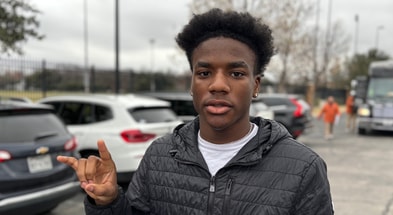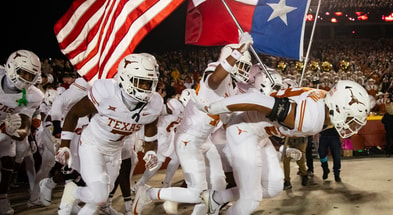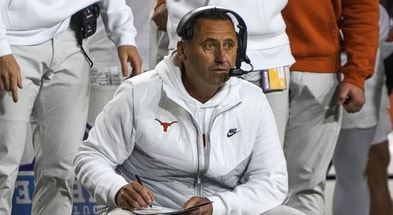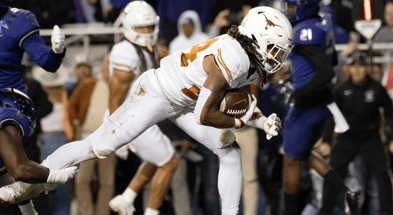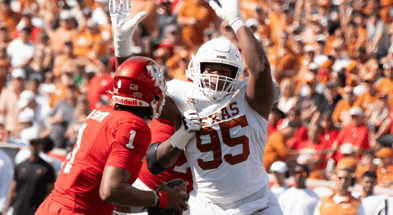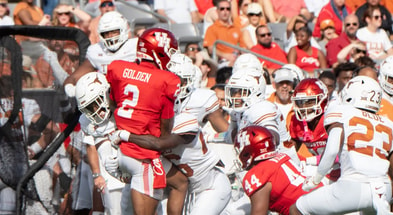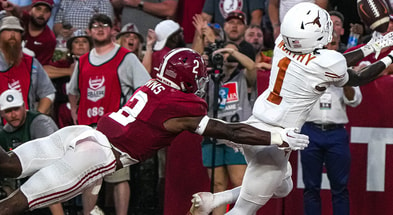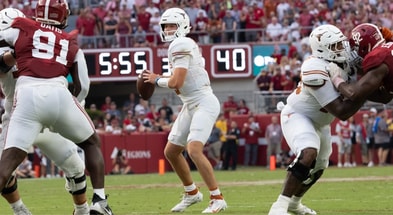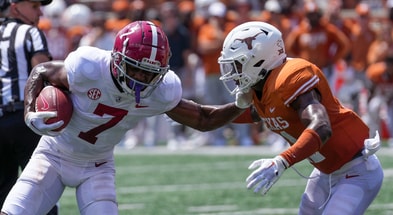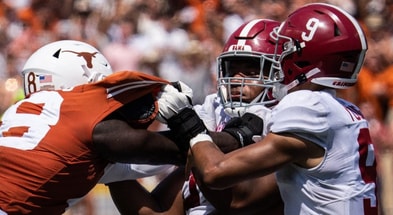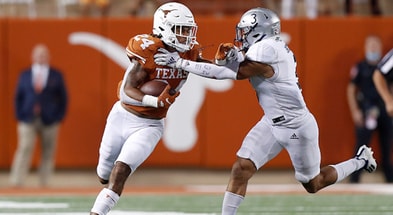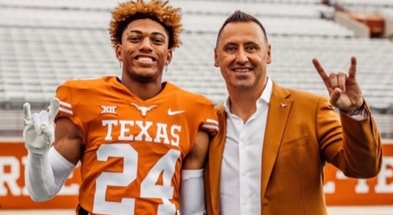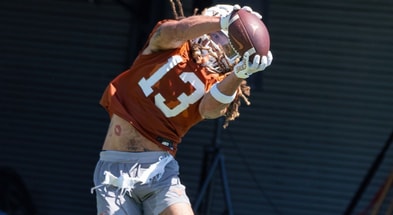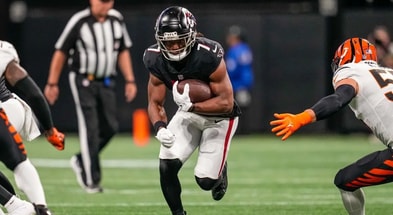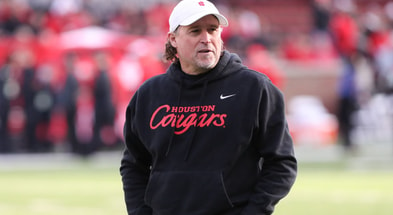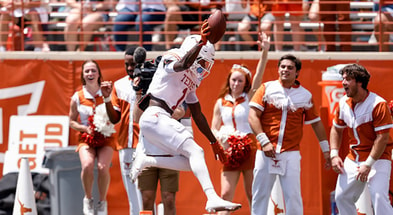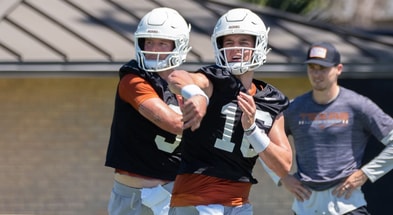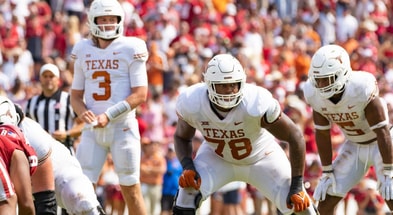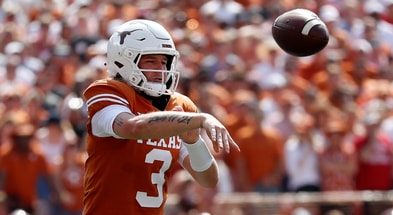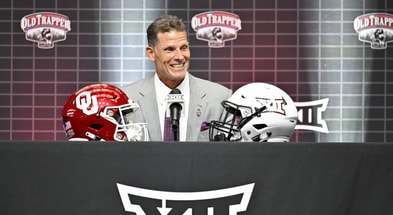Inside the Gameplan: Yurcich + Herman = ???

Want daily Texas Longhorns content on the latest team and recruiting information from Eric Nahlin, Justin Wells, Ian Boyd, Scipio Tex, and Joe Cook? Sign up HERE today!
Tom Herman’s biggest decision this offseason was deciding what steps to take on offense. Was he going to overhaul the approach with a hire like Graham Harrell? Tweak things with another power-spread assistant such as Rhett Lashlee? He basically split the difference between those two options when he poached Mike Yurcich from Ohio State.
The offense Yurcich managed for Mike Gundy was essentially the system that Dana Holgorsen had installed in 2010 and Gundy had left intact in subsequent seasons. He helped them stay ahead of the curve with RPOs and mixed in some other option elements now and again with J.W. Walsh but for the most part it was the same system that Gundy had hired Holgorsen to install and teach. Essentially, an Air Raid that had journeyed away from Mike Leach’s dropback heavy approach in favor of using the spread run game to set up the passing game with RPOs and play-action. I like to call this variety of offense the “smashmouth spread,” in which the goal is to use lead run schemes as a means of holding defensive attention in the box so that you can go about the more productive task of throwing the ball down the field.
That’s the most popular style of offense in the Big 12 these days and even Lincoln Riley has trended in that direction since running a more conventional Air Raid back at East Carolina. There are some notable differences between a smashmouth spread philosophy such as the sort Yurcich has run and the power-spread approach more familiar to Tom Herman and remaining assistant Herb Hand. However, it’s a step that is in keeping with what Texas has been doing and what they’ve recruited to be able to do in 2020.
Smashmouth spread vs power-spread
I define these styles by their intention, which are different even if many of the concepts overlap. As opposed to the more pure Air Raid style, which is driven by the dropback passing game, both the power-spread and smashmouth spread put a big emphasis on the run game from spread formations. The difference is that power-spread teams want to use spread spacing in order to allow them to pound the ball inside with runs and control the game in the trenches. Smashmouth spread teams use the inside run game to hold defensive attention in the box so they can isolate their athletes on the perimeter or down the field and score lots of points.
Now Tom Herman, who tried to run the ball from 12 personnel up by one and pinned deep on the road against Iowa State, is still the head coach. Is he going to be comfortable with an offensive approach designed to push the ball down the field more and win shootouts? Or will he ask Yurcich to tweak the play-calling and gameplan to be more methodical and protect the defense?
It’s going to be hard for the style of offense that Yurcich called at Oklahoma State to jive with a more plodding, ball-control approach from Texas. One of the key differences between the Herman offense and the Yurcich/Gundy offense is how they utilize the slot.
Since heading to Houston and Texas, Herman has used the slot as a place to feature the best skill player on the offense. Humphrey and Duvernay served as RPO targets in the run game on bubbles and occasionally slants. In the dropback passing game Houston and Texas flexed the TE out to create formations designed to match the slot up on the weakest pass defenders on the opposing team.
Meanwhile Yurcich has never had a slot receiver that he fed nearly as much as Herman has his main targets. The closest he’s come was with Jalen McCleskey in 2016 before Marcell Ateman returned from injury and relegated McCleskey to the No. 3 option, eventually leading to his transfer. The role of the slot is different in his offenses and is treated in more of a supporting role in pursuit of creating maximal spread stress on opponents.
For instance, here’s one of Herman’s favorite passing concepts that Texas has leaned on extensively to get the ball to Duvernay in big moments:
The idea is that the deep safety can only help on the post or the corner route and he’s going to tend to cover the post that’s the first threat to his normal zone, leaving the slot open on the corner route. This is typical of Herman’s passing game over the years, using the outside receivers on deeper patterns to create space underneath for the slot to break off into open grass. Texas has run four-verticals countless times over the years and the most common outcomes have been hitting a slot breaking off underneath, checking down to the RB, throwing a comeback outside, or Ehlinger scrambling. This corner route combo produced big gains but mostly in the form of third down conversions. You don’t hit a lot of explosive touchdown passes throwing to slot receivers breaking off routes underneath. It’s more of a ball control passing concept.
Here’s the sort of play Yurcich ran a million times for James Washington:
In this concept, as with most of their routes, the slot receivers are trying to command safety attention in the middle of the field in order to create the opening to hit the outside receiver on a post route. Whereas Herman was scheming to get the slot open breaking off his route against a safety with divided attention, Yurcich’s slots are often the first to run into zones the safety defends to draw their attention. Ultimately the bread and butter of the Gundy OSU offense has been the ability of star outside receivers to beat corners 1-on-1 running posts, curls, comebacks, and other standard routes. The slot receiver has typically served to prevent the safety from interfering.
The slot receivers certainly did some damage against safeties that tried to sit back to cover the post or help on the go route outside, or from taking advantage of linebackers trying to jump the shallow route or biting on play-action. Yurcich also enjoys mixing in slot fades as much as the next guy. But ultimately the idea is use to the slot to hold the attention of the safety so the ball can go outside to the star receivers in positions where they can score.
Blending run game systems
There are three substantial differences between the Yurcich run game at OSU and the Texas run game with Herman. One is that OSU’s approach to inside zone has always been more of a “catch and seal” system rather than the tight, downhill approach favored by Herman and Hand. Another is that Yurcich has always been aggressive in attaching pass-options, including vertical routes like skinny posts, whereas Herman was slow to incorporate those into his own offense. Again, Yurcich wants to throw the ball to receivers running down the field, Herman wants to use the threat of receivers to clear space to pound the ball with the RB behind double teams.
Finally, at OSU Yurcich rarely had dual-threat TEs and never let that get in the way of their offense. The Cowboys deployed a lot of fullbacks chosen for their blocking ability with Gundy even putting out calls at times for scrappy, Oklahoman HS OL who lacked the size to play OL in college to walk on to their football program and audition to be fullbacks. When they wanted to get from their 20 personnel looks into four-wide spread sets they didn’t use tempo and flex out the fullbacks but instead substituted in a fourth receiver.
The Herman approach is much better if you actually have the sort of FB/TE that can do both. The closest OSU has had was Blake Jarwin, whom they moved all over the place and often shielded from tough blocking assignments by giving those to one of their fullbacks in 21 personnel sets. In his senior year Jarwin only caught 19 balls for 309 yards and two TDs while the less route-savvy Andrew Beck hauled in 28 catches for 281 yards and two scores in his final season.
For the purposes of running play-action and RPOs, having a lead blocker off the ball and in the backfield (as Texas TEs often have been) is more useful since his movement towards the line of scrimmage can trigger linebackers and safeties to bite on run-action and leave time and space for receivers to break open. Yurcich regularly runs double vertical combinations with the slot and an outside receiver as in the diagram above off play-action. A FB insert can tend to do the same work as using another slot to run a shallow cross.
Yurcich and Oklahoma State (as well as Ohio State) also ran a good deal more outside zone than Texas has done in recent seasons. I think this was largely a function of what they could do and teach well rather than being essential to the system. Herman and Hand’s particular emphasis on inside zone should mesh well with Yurcich’s ideas and designs. Yurcich wants the run game to pick up steady gains and set up play-action and RPOs outside and Texas’ downhill zone schemes can certainly accomplish that aim.
Top 10
- 1New
AP Poll controversy
New Top 25 raises eyebrows
- 2
Penn State police warning
Saquon celebration triggers warning
- 3Trending
Kai Trump
President's granddaughter holds $1.2M NIL Valuation
- 4
New No. 1 in Coaches Poll
Top 25 shakeup
- 5
Ja'Juan Seider
ND targeting PSU assistant
Get the On3 Top 10 to your inbox every morning
By clicking "Subscribe to Newsletter", I agree to On3's Privacy Notice, Terms, and use of my personal information described therein.
We may see more variety in how the TE is involved with more iso/zone and draw schemes mixed in, or it may just look like it did in Austin the one year when Texas had a good blocker at that position (Andrew Beck).
For Yurcich, Herman, and Hand to come to an understanding of how to scheme up a marriage between Texas’ inside zone dominant system and Yurcich’s previous playbooks should be exceptionally easy and natural. In fact I doubt much changes about how Texas does anything up front although the accompanying RPO and play-action game will likely evolve and grow more aggressive.
How does this Texas roster compare to the better Yurcich offenses?
Probably the biggest question everyone will have is how well the prospective 2020 Texas offensive roster could hope to execute the Yurcich system. For some of the players on the roster, this change is going to be extremely helpful. Brennan Eagles should find the limited route tree and opportunities to simply overpower cornerbacks to be a godsend. If Texas abandons the “X receiver stays on the boundary” system they had for Collin Johnson’s benefit then the other outside receiver opposite Eagles should also be a big benefactor since they won’t have to spend all their time outside of the far hash.
It’ll be an interesting offseason for Jake Smith, who should have zero trouble executing the slot role in the Yurcich offense but may be capable of more. Either they could maintain some of Herman’s tricks for working the ball to the slot on passing downs or they could move Smith outside. Overall Texas has a lot of weapons at receiver that should translate well to this system.
Ehlinger’s mastery of the Larry Fedora-aided RPO game should make for an easier transition this year to Yurcich’s designs and he also demonstrated plenty of ability in 2019 to hit receivers outside the hash marks. Some of the timing and reads will be different and he’ll need to rep them this offseason but overall, Ehlinger is as talented a passer as Yurcich has yet coached and should also be well up to the task of choosing from a menu of plays at the line of scrimmage as Mason Rudolph did as a senior.
In the past Yurcich has tended to create space with his run blocking for speedier little RBs to make hay. Texas’ approach is more about shoving over defenders left in the box for bigger, power backs. That should be straightforward enough and there are some other gems from Yurcich’s offense that could be useful for utilizing these guys that we’ll explore later in the offseason.
Since Texas isn’t moving to more of a dropback approach, which I maintain would have been better, they still have to figure out who’s throwing the lead blocks for this team. Yurcich could comb the walk-on ranks for a Britton Abbott (an OSU fullback) or he may have to get creative with the roster or bank on improvements from Cade Brewer and Jared WIley. Much like in every previous season for Texas, how that goes could set the ceiling for the 2019 Longhorns under Mike Yurcich’s offensive play-calling.
Perfecting tempo
If there’s an area where Yurcich could stand to learn from Herman’s oversight it’s in utilizing 11 personnel and tempo. The OSU rosters didn’t have flexible enough personnel to fully maximize the possibilities of tempo with “force multiplier” schemes Texas has used the last few years such as the “touchdown play” or “QB stretch.” The fullbacks were basically blocking specialists and the slot receivers that replaced them in the four-wide sets were as well. OSU used tempo to great effect under Yurcich but Texas is more dangerous if they can blend the two approaches.
One area worth watching is the compressed formations that Texas used to great effect against Utah. Because they have so many big, physical receivers those formations were effective for helping to bounce inside zone runs to the edge for bigger gains. It’s also a useful counter to mix in when teams start playing man coverage to deal with RPOs. These sorts of formations are a major part of the current LSU offense, which also stays in 11 personnel all the time. If Texas has good TE play next season, this would be worth maintaining.
If there’s one area that Yurcich could upgrade the Texas tempo system it’d be in giving Ehlinger more control on the field. Texas allowed Ehlinger to run things at times but heading into his senior year they should be pushing their chips all in on allowing the star quarterback to control the game’s tempo at his own discretion in accordance with gameplans worked out during the previous week. The Longhorns’ best chances this season are going to come from lightning up the scoreboard and giving Ehlinger a lot of autonomy to notice when the time is right to chuck a post route to Brennan Eagles or a slot fade to Jake Smith rather than taking the steady four-yard gain on another tight zone run.
The Yurcich-Herman fit could be smooth and lead to a big increase in offensive production if the two share a philosophy on the best way to win the Big 12 in 2020.

